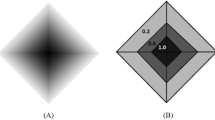Abstract
In any information system the reliability of any results of queries, analysis or reasoning, depends on data quality (positional accuracy, consistency and so on). In some cases, answers cannot be obtained due to a lack of information, whereas in other cases answers are wrong or not complete because of inconsistent data. In geographical information systems (GIS), data quality management has to handle the spatial features of objects, which brings specific problems. The goal of this paper is to describe a methodology for spatial consistency improvement of geographical data sets in vector format. It is based on errors survey and classification. Three kinds of errors are identified which lead to three kinds of consistency, namely structural consistency, geometric consistency and topo-semantic consistency. Each of them needs specific checking and correcting processes. All these processes are integrated in a general framework that is presented in this paper. An application of this framework to the Lyon Urban Community GIS (the SUR) is currently conducted; first results are presented.
Similar content being viewed by others
References
J. Corbett. Cartographic data structures. Washington DC: US Census Bureau, 1979.
Z. Cui, A.G. Cohn, and D.A. Randell. “Qualitative and Topological Relationships in Spatial Databases,” in Proceedings of the Third Symposium on Large Spatial Databases, SSD'93, Singapore, June 23-25, Lecture Notes in Computer Science 692:296–315, 1993.
M.J. Egenhofer and J.R. Herring. “A Mathematical Framework for the Definition of Topological Relationships,” in Proceedings of the 4th International Symposium on Spatial Data Handling, SDH-90, Zurich, 803–813, 1990.
M.J. Egenhofer and J.R. Herring. Categorizing Binary Topological Relations Between Regions, Lines, and Points in Geographic Databases. Technical Report, Department of Surveying Engineering, University of Maine, Orono, 1991.
M.J. Egenhofer. “Reasoning about Binary Topological Relations,” in Proceedings of the Second Symposium on Large Spatial Databases, SSD'91, Zurich, Lecture Notes in Computer Science 525:143–159, 1991.
J. Egenhofer and R.D. Franzosa. International Journal of Geographical Information Systems, Vol. 5(2):161–174, 1991.
S. Faiz. Modélization, exploitation et visualization de l'information qualité dans les bases de données géographiques, Ph.D. thesis, University Paris Sud—Orsay, 1997.
T. Hadzilacos and N. Tryfona. “A Model for Expressing Topological Integrity Constraints in Georaphic Databases,” in Proceedings of Theories and Methods of Spatio-Temporal Reasoning, GIS-92, Pisa, 253–368, 1992.
D.P.W. Jayawardena and M.F. Worboys. “The Role of Triangulation in Spatial Data Handling,” Innovation in GIS, Vol. 2: Taylor & Francis, 7–17, 1995.
W. Kainz. “Logical Consistency,” in Elements of Spatial Data Quality, Elsevier Science, 109–138, 1995.
R. Laurini and D. Thompson. Fundamental of Spatial Information Systems. Academic Press, 1992.
J. Morrison, “Spatial data quality,” in Elements of spatial Data Quality, Elsevier Science, 1–12, 1995.
T. Peucker and N. Chrisman. “Cartographic Data Structures,” The American Cartographer, 55–69, 1975.
L. Plümer, “Achieving Integrity and Topology in Geographical Information Systems,” in Proceedings of the First International Conference on Geographic Information Systems in Urban Regional and Environmental Planning, Samos, GR, 45–60, 1996.
F.P. Preparata and M.L. Shamos.Computational Geometry: An Introduction, Springer Verlag New York, 1986.
F. Salge. “Semantic accuracy,” in Elements of spatial Data Quality, Elsevier Science, 139–152, 1995.
T. Ubeda and S. Servigne. “Capturing Spatial Object Characteristics for Correcting and Reasoning,” in Proceedings of Joint European Conference and Exhibition on Geographical Information, JEC-GI-96, Barcelona, Spain, 24–33, 1996.
T. Ubeda and S. Servigne. “Geometric and Topological Consistency of Spatial Data,” in Proceedings of the First International Conference on Geocomputation, Leeds, UK, 830–842, 1996.
T. Ubeda and M.J. Egenhofer. “Topological Error Correcting in GIS,” in Proceedings of the fifth international symposium on spatial databases, SSD-97, Berlin, Germany, 283–297, 1997.
H. Veregin and P. Hargitai. “An evaluation matrix for geographical data quality,” Elements of spatial DataQuality, Elsevier Science, 167–188, 1995.
M.F. Worboys. GIS A Computing Perspective, Taylor & Francis, 1995.
G. Zhang and J. Tulip. “An Algorithm for the Avoidance of sliver Polygons and Cluster in Spatial Overlays”, in Proceedings of the fourth international Symposium on Spatial Data Handling, SDH-90, Zurich, Switzerland, 141–150, 1991.
Author information
Authors and Affiliations
Rights and permissions
About this article
Cite this article
Servigne, S., Ubeda, T., Puricelli, A. et al. A Methodology for Spatial Consistency Improvement of Geographic Databases. GeoInformatica 4, 7–34 (2000). https://doi.org/10.1023/A:1009824308542
Issue Date:
DOI: https://doi.org/10.1023/A:1009824308542




